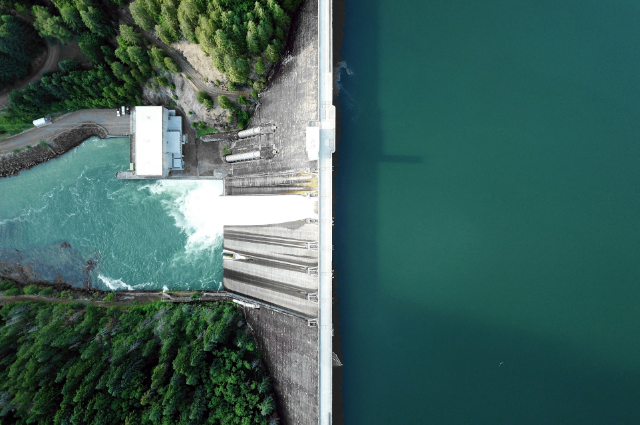
In the urban landscape, cities grapple with a myriad of sustainability challenges that fundamentally impact the well-being of both their inhabitants and the surrounding environment. Among these pressing concerns are the pervasive issues of pollution, congestion, and resource depletion.
- Pollution, in its various forms, including air, water, and soil pollution, poses a significant threat to public health and ecological balance. The accumulation of pollutants not only compromises air quality, leading to respiratory illnesses and other health complications among urban residents, but also contaminates water sources, endangering aquatic life and human consumption. Moreover, soil pollution undermines agricultural productivity and can result in long-term environmental degradation.
- Congestion, exacerbated by rapid urbanization and inadequate transportation infrastructure, engenders a host of socioeconomic and environmental repercussions. Gridlocked roads not only impede the flow of goods and services, hindering economic productivity, but also contribute to heightened levels of stress, reduced quality of life, and increased carbon emissions from idling vehicles. The toll of congestion extends beyond mere inconvenience, impacting public health, economic competitiveness, and social cohesion within urban communities.
- Resource depletion, driven by unsustainable consumption patterns and inefficient resource management practices, poses a grave threat to the long-term viability of cities. From dwindling freshwater supplies to the depletion of natural habitats and non-renewable energy sources, the unsustainable exploitation of resources jeopardizes the resilience and ecological integrity of urban ecosystems. Left unchecked, resource depletion could precipitate ecological crises, exacerbate social inequalities, and undermine the very foundation of urban development.
How can we, as residents of urban environments, actively contribute to addressing these sustainability challenges and fostering a more resilient and environmentally conscious future for our cities?
GREEN INFRASTRUCTURE SOLUTIONS:
- Innovative green infrastructure solutions that cities are implementing to enhance sustainability.
- How these initiatives help to mitigate issues.

Photo by Daniel Funes Fuentes on Unsplash
1. GREEN ROOFS:
- Green roofs, adorned with vegetation, offer a multifaceted approach to sustainability.
- They absorb and filter rainwater, reducing stormwater runoff and alleviating pressure on urban drainage systems.
- Acting as natural insulators, they decrease energy consumption for heating and cooling, contributing to energy efficiency in buildings.
- By providing shade and evaporative cooling, green roofs help mitigate the urban heat island effect, enhancing local microclimates and reducing ambient temperatures in urban areas.
2. PERMEABLE PAVEMENTS:
- Permeable pavements allow water to infiltrate through the surface rather than runoff, addressing stormwater management challenges.
- They promote groundwater recharge and improve water quality by reducing surface runoff and filtering pollutants.
- By mitigating flooding risks, permeable pavements enhance urban resilience to extreme weather events.
- These pavements also contribute to mitigating the urban heat island effect by reducing the amount of heat-absorbing impervious surfaces, thus moderating local temperatures.
3. RAIN GARDENS:
- Rain gardens are strategically designed vegetated areas that capture and absorb stormwater runoff.
- They help to prevent soil erosion and reduce the flow of pollutants into water bodies, thereby enhancing water quality.
- By promoting infiltration and groundwater recharge, rain gardens contribute to managing stormwater at its source.
- These green spaces beautify urban landscapes while providing habitat for native flora and fauna, fostering biodiversity in urban environments.
4. URBAN FORESTS:
- Urban forests, comprising trees and vegetation within cities, offer numerous environmental and social benefits.
- They help to mitigate air pollution by absorbing carbon dioxide and other pollutants, improving air quality and public health.
- Urban forests provide shade and cooling effects, reducing energy consumption for cooling in urban areas.
- By enhancing biodiversity and providing habitat for wildlife, urban forests contribute to ecosystem resilience and ecological balance in cities.
RENEWABLE ENERGY INITIATIVES
Various renewable energy initiatives that cities are adopting.

1. SOLAR ENERGY PROJECTS:
Cities are increasingly investing in solar energy initiatives, leveraging the abundance of sunlight to generate electricity sustainably. Solar photovoltaic (PV) panels, installed on rooftops or in solar farms, harness solar energy and convert it into electricity, reducing reliance on fossil fuels.
Solar energy projects contribute to reducing carbon emissions and mitigating climate change while promoting energy independence and resilience in urban energy systems.
2. WIND ENERGY PROJECTS:
Wind energy initiatives involve harnessing the power of wind through wind turbines to generate electricity. Cities situated in windy regions or offshore locations are investing in wind farms to tap into this renewable energy source.
Wind energy projects offer a clean and abundant source of electricity, helping cities to diversify their energy mix and transition away from fossil fuels.
3. HYDROELECTRIC ENERGY PROJECTS:
Hydroelectric power utilizes the energy of flowing water to generate electricity, often through dams and turbines. Cities with access to rivers or waterways are implementing hydroelectric energy projects to generate clean and renewable electricity.
Hydroelectric power is a reliable source of energy that can provide baseload power, complementing intermittent renewable sources like solar and wind.
4. GEOTHERMAL ENERGY PROJECTS:
Geothermal energy initiatives tap into the heat stored beneath the Earth's surface to generate electricity or provide heating and cooling. Cities located in geologically active areas or with access to geothermal reservoirs are exploring geothermal energy as a sustainable alternative to fossil fuels.
Geothermal energy projects offer a continuous and reliable source of power with minimal environmental impact, contributing to carbon emission reductions and energy security.
5. ENERGY EFFICIENCY MEASURES:
In addition to renewable energy generation, cities are prioritizing energy efficiency measures to reduce overall energy consumption. This includes retrofitting buildings with energy-efficient technologies, implementing smart grid systems, and promoting energy-saving practices in transportation and industry.
Energy efficiency initiatives not only reduce carbon emissions but also lead to cost savings, improved air quality, and enhanced resilience to energy supply disruptions.
CASE STUDIES

1. Copenhagen, Denmark
- Biking Culture: Over half of the city's residents use bikes as their primary mode of transportation, facilitated by dedicated bike lanes and parking spots.
- Public Transportation: Comprehensive public transportation system including buses, trains, and metro, reducing traffic congestion and carbon emissions.
- Renewable Energy: Commitment to become carbon-neutral by 2025, with investments in wind turbines, solar panels, and waste management for reducing CO2 emissions.
2. Amsterdam, Netherlands
- Bike-Friendly Infrastructure: Extensive network of bike lanes and parking facilities, making biking accessible and safe.
- Sustainable Building Design: Emphasis on architecture promoting natural light and ventilation, along with green spaces integrated into urban planning.
- Circular Economy Initiatives: Implementation of Circular Strategy 2020–2025 and Circular Economy Monitor (CEM) for tracking progress and promoting sustainability.
3. Vancouver, Canada
- Green Mobility Options: Focus on public transportation, biking infrastructure, and car-sharing programs for reducing carbon footprint.
- Eco-Friendly Buildings: Adoption of energy-efficient designs and renewable energy sources in building construction.
- Abundant Green Spaces: Over 230 public parks and community gardens for recreation and environmental conservation.
4. Curitiba, Brazil
- Efficient Public Transportation: Bus rapid transit (BRT) system with dedicated lanes and electric buses serving over 2 million passengers daily.
- Green Spaces: Prioritization of green spaces, with over 50 square meters per resident and emphasis on waste management and recycling.
- Sustainable Building Practices: Promotion of sustainable building design and energy-efficient practices in urban development.
5. Portland, United States:
- Robust Public Transportation: Investment in buses, light rail, and bike-friendly infrastructure for sustainable mobility options.
- Sustainable Practices: Reduction of greenhouse gas emissions by 21% since 1990 through energy-efficient building designs and recycling programs.
- High-Quality Green Spaces: Abundance of public parks and natural areas for recreational activities and environmental preservation.
6. Singapore
- Efficient Public Transportation: Extensive network of buses, trains, and subways, considered among the most efficient globally.
- Abundant Green Spaces: Integration of parks, nature reserves, and gardens throughout the city, reducing the urban heat island effect.
- Waste Management: Emphasis on recycling and composting, with 61% of waste being recycled or composted, showcasing commitment to sustainability.
These cities exemplify near-perfect urban planning through a combination of sustainable transportation, eco-friendly building practices, abundant green spaces, and effective waste management strategies. Their holistic approach serves as a blueprint for creating livable, resilient, and environmentally conscious cities of the future.
CHALLENGES IN SUSTAINABLE URBAN PLANNING
- Challenges and barriers that cities face in transitioning to more sustainable urban planning practices.
- Potential strategies for overcoming these challenges and outline future directions for advancing sustainability in urban areas.

1. Financial Constraints:
- Analysis: One of the primary challenges cities face in transitioning to sustainable urban planning practices is the financial burden associated with implementing green infrastructure and renewable energy initiatives.
- Implications: Limited budgets may hinder the adoption of sustainable technologies and infrastructure, delaying progress towards environmental goals.
- Strategies: Cities can explore innovative financing mechanisms such as public-private partnerships, green bonds, and incentive programs to attract investment in sustainability projects. Additionally, leveraging grants and subsidies from government agencies and international organizations can provide much-needed financial support.
2. Regulatory Hurdles:
- Analysis: Complex regulatory frameworks and bureaucratic processes often pose significant barriers to implementing sustainable urban planning initiatives.
- Implications: Lengthy approval processes and conflicting regulations can impede progress and discourage investment in green infrastructure projects.
- Strategies: Cities should streamline permitting processes, revise zoning ordinances to incentivize sustainable development, and establish clear regulatory guidelines for renewable energy projects. Collaborating with stakeholders to identify regulatory barriers and advocating for policy reforms can facilitate smoother implementation of sustainability initiatives.
3. Public Resistance:
- Analysis: Public resistance to change, skepticism about the effectiveness of sustainable practices, and concerns about potential disruptions to daily life can hinder the adoption of sustainable urban planning measures.
- Implications: Without public support, efforts to implement sustainability initiatives may face opposition and encounter challenges in gaining traction.
- Strategies: Cities should prioritize community engagement and education initiatives to raise awareness about the benefits of sustainable urban planning and address misconceptions. Engaging with residents, businesses, and community organizations through public forums, workshops, and outreach campaigns can build consensus and garner support for sustainability efforts.
FUTURE DIRECTIONS IN SUSTAINABLE URBAN PLANNING:
1. Embracing Emerging Technologies:
- Analysis: Rapid advancements in technology present new opportunities for enhancing sustainability in urban areas, from smart grids and energy-efficient buildings to electric mobility and digital infrastructure.
- Implications: Integrating emerging technologies into urban planning strategies can optimize resource utilization, improve efficiency, and reduce environmental impact.
- Strategies: Cities should invest in research and development to harness the potential of emerging technologies for sustainable urban development. Collaborating with technology firms, academic institutions, and innovation hubs can foster the creation of cutting-edge solutions tailored to urban sustainability challenges.
2. Policy Innovations:
- Analysis: Effective policy frameworks are essential for driving systemic change and incentivizing sustainable practices across sectors.
- Implications: Policy innovations such as carbon pricing, green building codes, and renewable energy mandates can create a conducive environment for sustainable urban planning.
- Strategies: Cities should enact ambitious sustainability goals and implement supportive policies that align with international best practices. Adopting a multi-level governance approach, involving collaboration between local, regional, and national governments, can facilitate policy coherence and coordination.
3. Community Engagement Efforts:
- Analysis: Meaningful engagement with communities is critical for ensuring the success and long-term viability of sustainable urban planning initiatives.
- Implications: Empowering residents to participate in decision-making processes and co-designing solutions can foster ownership and social cohesion.
- Strategies: Cities should prioritize inclusive and participatory approaches to urban planning, incorporating feedback from diverse stakeholders into decision-making processes. Establishing community advisory boards, neighborhood councils, and participatory budgeting mechanisms can facilitate dialogue and foster a sense of ownership over sustainability initiatives.
CONCLUSION:
while cities face challenges in transitioning to sustainable urban planning practices, there are ample opportunities for overcoming these obstacles and advancing sustainability in urban areas. By addressing financial constraints, regulatory hurdles, and public resistance through innovative strategies and collaborative efforts, cities can pave the way for a greener, more resilient, and equitable future. Embracing emerging technologies, implementing policy innovations, and engaging communities are key pillars for driving progress towards sustainable urban development goals.
